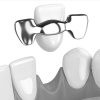Gum Disease or Periodontal Disease
If you have been diagnosed with periodontal or gum disease, you are not in the minority. Your Springfield dentist sees many adults that have some form of this condition. Gum disease can range from simple inflammation to a serious disease that results in major damage to the soft tissue and bone that support the teeth. In the worst cases, teeth are lost. Whether your gum disease is stopped, slowed or gets worse depends upon how well you care for your teeth and gums every day for the rest of your life.
What is Gum Disease?
This condition is the result of gingivitis that is untreated. Plague, tartar and bacteria in the mouth can cause the gums to become inflamed and bleed. This is what causes gingivitis, but if the condition worsens, it turns into what your Springfield dentist refers to as periodontal disease. The gums begin to erode, exposing nerves and dentin. Pockets develop between the teeth that become inflamed and the body’s immune system destroys the connective tissue as well as the bone in the mouth while fighting the infection.
How is This Treated?
Fortunately, there are many different treatments for this disease with the main goal of your Springfield dentist being to stop its progression.
Here are the most common methods used to treat this condition:
- Scaling and root planing. This is a deep cleaning below the gumline and of all the teeth to clean out any infection.
- Pocket reduction or flap surgery. If the gum tissue is not attached firmly to the tooth, your dentist can pull back the flaps of the gum surrounding the teeth to clean them so they reattach.
- Gum grafts. As the gums recede, the nerves are exposed. Tissue from the roof of your mouth can be placed in these spots to reduce exposure and prevent further gum loss.
- Bone grafting. If the disease has progressed too deeply and the bone is highly infected, synthetic or natural bone can be placed in this area along with regenerative tissue to allow the bone to grow back on its own.




